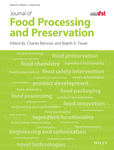Optimization of fermentation conditions for ting production using response surface methodology
Funding information: University of Johannesburg (Global Excellence and Stature Fellowship to OAA); National Research Foundation (NRF) Center of Excellence (CoE) in Food Security co-hosted by the University of Pretoria (UP) and the University of the Western Cape (UWC), South Africa
Abstract
This study investigated the effect of fermentation conditions (time and temperature) of sorghum on the composition of ting, using the Doehlert design of response surface methodology (RSM). Fermentation temperature and time were optimized and pH, titratable acidity (TTA), total viable bacteria count (TBC), total lactic acid bacteria count (TLABC), total fungal and yeast count (TFYC), tannin content (TNC), total phenolic content (TPC), total flavonoid content (TFC), and antioxidant activities (AA) were determined. Experimental and predicted values obtained were similar, with statistical indices indicating the validity of the models generated (R2 between 93.45 and 99.71%, AAD values close to 0, Bf and Af values close to 1). Numerical multi-response optimization of parameters suggested optimal fermentation conditions to be 34 °C for 24 hr. Physicochemical characterization of ting samples using scanning electron microscopy (SEM), X-ray diffraction (XRD), and Fourier Transform Infrared Spectroscopy (FTIR) showed slight changes in morphology, similarity in diffraction patterns and presence of different functional groups, respectively. Results of this study could provide information for the commercialization of quality ting.
Practical applications
Response surface methodology was used to study the influence of fermentation conditions on the quality of ting and optimal fermentation conditions were obtained at 34 °C for 24 hr. The findings in this study will be useful for ting processors to obtain a product with maximal beneficial composition and traits.




